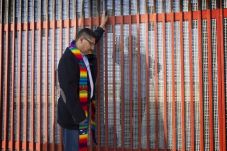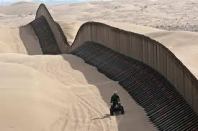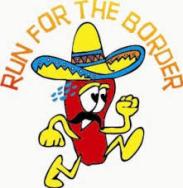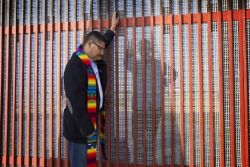All along the U.S. / Mexico border, government agents and armed vigilantes mobilize to stop the invasion of dirty (diseased), or lazy (go on welfare), or persistent (take our jobs away), or dangerous (bad hombres) “illegal aliens.” But mostly, we build walls to keep out the Other (unless we need him or her to work in our fields, construct our buildings, watch our children and elderly, mow our lawns, cook our food, and wash our dishes).
Trump was hardly the first politician to stir up anti-immigrant hysteria with talk of border walls.
The history of Native / Latino / White relations along the southern border is immensely long and complicated, far more so than this essay can encompass. For an overview, including a discussion of the Bracero Program, see here.
American attitudes toward Mexican immigrants began after the Civil War, when there still were no restrictions, says Aviva Chomsky:
This is because Mexicans are used differently by the country; they’re used as temporary, disposable workers…we can’t have Asians coming because they’ll have babies who will be citizens by birth, so instead we’ll rely on Mexican labor because we can deport them before they will have children…It is a lot easier to deport Mexicans than it is to deport anyone else. A pattern of circular migration—recruitment, deportation, recruitment, deportation—characterizes Mexican migration from the middle of 19th century, really, to the present.
American memory is short, and few remember that mass deportations have occurred before. Some of the worst racial violence in U.S. history took place along the Mexico-Texas border between 1900 and 1930. During the Depression years, up to 2 million Mexicans and Mexican-Americans were violently expelled from cities and towns across the U.S. and deported, or “repatriated.” Some researchers claim that more than half of these people were U.S. citizens, born in the United States.
But shortly afterwards, World War Two began and the nation quickly experienced labor shortages. So it instituted the Bracero Program, which allowed some 4.5 million Mexicans to cross the border legally. But by the early 1950s, with the troops home, it instituted “Operation Wetback,” a military-style operation that rounded up more than 1 million people. In her book Impossible Subjects, Mae Ngai writes that many Mexicans were deported by ship. A congressional investigation compared the conditions on these ships to that of an “eighteenth century slave ship.” Immigration authorities simply dumped hundreds of thousands of braceros across the border:
Some 88 braceros died of sunstroke as a result of a roundup that had taken place in 112-degree heat, and [an American labor official] argued that more would have died had the Red Cross not intervened. At the other end of the border, in Nuevo Laredo, a Mexican labor leader reported that ‘wetbacks’ were ‘brought [into Mexico] like cows’ on trucks and unloaded fifteen miles down the highway from the border, in the desert.
Nothing new here. As Woody Guthrie wrote: All they will call you will be deportee.
“Illegal” immigration and the hardening of the southern border began in 1965, when Congress overhauled the immigration laws. Now, instead of a discriminatory system that treated people differently based on their race, the new system claimed to treat all people equally. But for the first time, it placed numerical restrictions on Mexican immigration, a mere 20,000/year. Hundreds of thousands of people had been crossing the border in order to work and were then either leaving voluntarily or being deported. Their labor was necessary but the country did not want them as citizens. This is when forms of border crossing that had been happening for years suddenly became termed “illegal.” Chomsky writes:
…especially through the Immigration Reform and Control Act of 1986, crossing the border to work has become a much more perilous and dangerous process. Hundreds of people die every year crossing the border, and many more people who would prefer to continue this circular process were forced to stay in the United States because crossing the border became too dangerous, so they could not return home and hope to come back at a future point in time. So paradoxically, all these attempts to build walls and militarize the border, rather than leading to a decrease in the population of undocumented immigrants in the United States have led to a huge increase in the undocumented population in the US, because they have made it so hard to cross the border that once people are in, they are afraid to go home.
So our current regime of illegality that brings Mexicans into the country defines them as illegal and thus, deprives them of rights and makes them deportable. Now, illegality is the rationale for that system, but that system isn’t really that different than the system that has existed for years—of bringing Mexicans into the country and then deporting them. It’s just that before 1965, it was justified on the basis of race, and now it’s justified on the basis of illegality which was created solely for Mexican workers.
What has changed since1965? Let’s remember that to look at our history through an archetypal lens we have to keep in mind that the American psyche thinks in mythic dualities, in this case both the Inner Other and the Outer Other – and that violence against the former seems to always erupt alongside similar violence against the latter. Let’s take a very quick look at the previous hundred years:
The massive carnage of the Civil War was followed by terrorism and continuous racialized violence. During Reconstruction the Ku Klux Klan murdered (by some estimates) 20,000 Black people. The 1870s and 1880s saw many anti-Chinese riots in the far west.
The Indian Wars culminated in the 1890 massacre at Wounded Knee. The period between 1900 and the early 1920s saw many large-scale anti-Black riots, most notably in East St. Louis in 1917, Chicago in 1919, the 1921 destruction of the Black section of Tulsa, Oklahoma and the 1923 destruction of Rosewood, Florida. Meanwhile, as I mentioned above, whites murdered thousands of Mexican-Americans in the Southwest. In 1943 race riots convulsed cities around the U.S., from Southern California’s infamous “zoot suit riots” to widespread conflicts in St. Louis, New York and especially Detroit.
Take note that this violence, along with that in 1917 – as well as the New York City “Draft Riots” – all occurred around periods when the nation was at war against various Outer Others. Take note also that almost every instance in this century of violence was perpetrated by whites against people of color. So what happened in 1965, a century after the end of the Civil War?
The Inner Other, which had begun to began to speak up ten years before, began to act out. The 1965 Voting Rights Act followed the previous year’s Civil Rights Act. The first large escalation of the Viet Nam War happened. And Watts erupted in the first of many large-scale, black-on-white riots. The phrase “black power” was first spoken in public in 1966. The American Indian Movement was founded two years later. And the Chicano moratorium happened in 1968.
The Bracero Program had concretized the concept of Mexicans as temporary and “illegal” workers in the American psyche. And it also established an insatiable appetite in American farmers for a constant supply of cheap labor. Even though the Bracero Program was regulated, it was also manipulated. Dual systems of labor — one legal, one illegal — operated side by side. A surplus of workers benefited employers, who could more easily exploit their workers. Now, even as Mexican-Americans were demanding their rights, the white public imagination was beginning to perceive them as criminals infiltrating the borders of the nation, and of white identity.
The 1965 law dismantled quotas and established country caps. These new caps, seemingly more egalitarian, were nowhere near enough to meet labor demands. Thus, many Mexicans simply came the way they had always come — without documents — but now they were considered “illegal.” The U.S. Border Patrol first began to erect physical barriers in its San Diego sector in 1990, ultimately erecting fourteen miles of fencing.
The NAFTA free trade agreement of 1994 (again, under Bill Clinton’s watch) devastated the Mexican rural economy. A system that had worked for centuries was flooded by corn from the U.S. market. It undermined government protections for poor farmers, and the result was a massive increase in migration northward of formerly independent farmers who could no longer make a living at home. They were, said one historian, “refugees of NAFTA.”
Then came the tragedy of 9/11, ironically an attack on the World Trade Center. As I mentioned above in Part Six, the Paranoid Imagination does not discriminate between inner and outer. Whenever we evoke one pole of the archetype of the Other (the outer Other, formerly communism, now terrorism), the other, inner pole (race) automatically constellates. The long-term, seasonal, circular migration of Mexicans that had attracted little national attention suddenly became a highly visible violation of American sovereignty by hostile aliens whom the media increasingly framed as criminals. In 2006 state legislatures introduced over 1,400 immigration measures – a number that exceeded the total of the previous ten years. But now, instead of demonizing “Mexicans,” racists had a new rationale:
…we do see something similar to the fervor we’re seeing today, say, in the 19th century, in the early 20th century, but it was always expressed in explicitly racial terms…the term of illegality that’s (now) applied to so many of the immigrants that are crossing the border is an extraordinarily racialized term that has almost come to replace race. It’s not legitimate to openly discriminate on the basis of race anymore but if we replace race with legal status suddenly it becomes legitimate to openly discriminate…“Although, on the surface, the system is color-blind, in fact, it targets people of color. But it works better in this supposedly postracial age, because it never uses race directly to discriminate. Instead, it criminalizes people of color then discriminates on the basis of their criminal status.
In 2006 G.W. Bush signed the “Secure Fence Act,” and by 2011 DHS had completed some 650 miles of border walls and fences. The government later reported that illegal border-crossers had simply found new routes, that the fences had been breached thousands of times, and that the Secure Fence Act caused at least 2000 additional deaths.
The Republican Party’s 2012 platform called upon “double-layered fencing” to be built as originally called for in 2006 law. But by 2016 white reactionary anger was seething after eight years under Obama (who, lest we forget, deported more people in each of those years than Trump would in 2017). Trump saw his opening and led the nation into its current round of hysteria over Muslim terrorists, Mexican criminals, DACA, “chain migration,” more border wall construction, and massive increases in the budgets and personnel for Homeland Security and ICE (Immigration and Customs Enforcement).
As wasteful and harmful as these expenditures have been, we must understand that they are a natural reaction to the fact that American culture, and white male identity in particular, are falling apart. We no longer know who we are, and so we turn to the old reliable medicine (if only brief in its effects, like all drugs): hatred of the Other.
In Part Six I wrote about the (mostly negative) images that the American paranoid imagination has projected onto Mexicans, and the social price that both nations have paid for our refusal to acknowledge our own fantasies of liberation from the Puritan repression of our indigenous souls. When we see those images instead of actual persons, we are seeing stereotypes.
But when mythologists hear of stereotypes, we take the cue and look deeper, in search of the archetypes. We think of other famous walls built to keep out the barbarians in China, in the West Bank, in Berlin. Some of those walls, of course, were built to prevent the citizenry from escaping. Gaza, for example. We know that when it’s convenient, gatekeepers such as Ronald Reagan will happily stand with the majority (“Mr. Gorbachev, tear down this wall!”) for a photo-op. And when it isn’t, they won’t.
To conclude, let’s shift back to older mythologies. We remember the great walls that were unable to keep Dionysus and his bacchants out of Thebes. In archetypal terms Dionysus is the Other who destroys inappropriate boundaries. Here is his basic rule: the higher and thicker the walls, the greater the repression (or oppression), the more furious and unforgiving his response. Or if you prefer: the brightest lights cast the darkest shadows. Like the mestizos (hybrids of Spain and Native America) coming to reclaim their territory – or like the Palestinians who are indigenous to their land – he penetrates the defenses on his way home, because he is our own self. But Dionysus can destroy the walls – and perhaps the whole city – when he is disrespected.
His half-brother Hermes offers us an alternative to the explosive return of the repressed. He mediates the boundaries (physical, social and mental) rather than destroying them. So Hermes is the patron deity of those who live at or attempt to cross the borders: traders, translators, gamblers, furniture movers, psychotherapists, negotiators, diplomats, bankers, smugglers, thieves and all travellers, including immigrants. Read here for a more detailed discussion.
Hermes is Trickster and Guide of Souls, leading the dead into the underworld. But he is also the awakening angel who leads Orpheus, Persephone and Odysseus back out of the darkness. Trickster offers us the possibility of seeing the world from a new perspective, challenging our rigidities and privileged perceptions. This boundary-crosser can also create new boundaries, borders, symbols, metaphors and forms of community. But, as Lewis Hyde explains, if we close the borders to the healing that Hermes offers, we must face the rage of Dionysus:
There is no way to suppress change, the story says, not even in Heaven; there is only a choice between a way of living that allows constant, if gradual alterations and a way of living that that combines great control and cataclysmic upheavals. Those who panic and bind the trickster choose the latter path.
In certain schools of Native American wisdom it is highly recommended to invite trickster into the tent so that he is pissing outward, rather than keeping him outside the tent and pissing inward. So we recall one more stereotype: “making a run for the border,” both the movie trope and the Taco Bell ad.
Imagine the gatekeepers relaxing their vigilance long enough to acknowledge the truth that both Hermes and Dionysus have been telling us: the Other has so much to offer. Imagine the good citizens happily running into the arms of the Other, moving gladly into liminal space, taking refuge in otherness. There is a graffiti on the Mexican side of the border fence: Turn this wall on its side and make a bridge!
It’s time to start asking ourselves certain questions. Isn’t migration built into human DNA? Haven’t we been migrating ever since we became a species? Isn’t this how humans came to populate the earth? Why only in the last century or so have nation states tried to restrict such movement? Didn’t most societies survive quite well without doing this? If American citizens assume the freedom to travel, why does the U.S. bar some people – mostly poor people and people of color – from other countries from coming here? Why should the accident of birth determine who can travel and who cannot? If we don’t allow public parks, towns, counties or states to regulate who is allowed to enter their spaces, why can countries do it? If we agree – most of us – that it is wrong to treat people differently based on their religion, race, gender, etc, why do nations discriminate based on nationality (generally determined by where a person is born)?
Ultimately, of course, we have to ask, why do we have borders at all? From an anarchist perspective, we understand them this way: borders serve the national state rather than the individuals who comprise it. Alex Tabarrock writes that there are strong cases, both moral and economic, for getting rid of all borders:
All people should be free to move about the earth, uncaged by the arbitrary lines known as borders…What moral theory justifies using wire, wall, and weapon to prevent people from moving to opportunity? What moral theory justifies using tools of exclusion to prevent people from exercising their right to vote with their feet?
No standard moral framework, be it utilitarian, libertarian, egalitarian, Rawlsian, Christian, or any other well-developed perspective, regards people from foreign lands as less entitled to exercise their rights—or as inherently possessing less moral worth—than people lucky to have been born in the right place at the right time. Nationalism, of course, discounts the rights, interests, and moral value of “the Other”, but this disposition is inconsistent with our fundamental moral teachings and beliefs.
Here is another great contradiction that the myth of innocence attempts to conceal: the people who have enshrined radical individualism like no other in history have a vast shadow of conformism, crusades against alternative thinking, willing subservience to a highly centralized national state that sacrifices their children in constant warfare, and an easy willingness to ignore their own professed values.
The Other stands at the border, and we fear him. “Xenophobia” stems from the Greek word xenos, or “stranger.” But depending on the context in a sentence, xenos can also mean “guest,” while “love of the guest” is philos-xenos. Here is the work of the imagination: One who is actually secure in his/her sense of his/her self has no need to demonize the other. He /she/they would define themselves in positive terms, rather than in terms of what they are not. But this requires listening to both the griefs and the blessing that the Other offers. D. H. Lawrence was willing to listen to the Other:
What is the knocking? What is the knocking at the door in the night? It’s somebody wants to do us harm. No, no, it is the three strange angels. Admit them, admit them.
In the previous essay I wrote about the (mostly negative) images that the American paranoid imagination has projected onto Mexicans, and the social price that both nations have paid for our refusal to acknowledge our own fantasies of liberation from the Puritan repression of our indigenous souls. When we see those images instead of actual persons, we are seeing stereotypes.
But when mythologists hear of stereotypes, we take the cue and look deeper, in search of the archetypes. We think of other famous walls built to keep out the barbarians in China, in the West Bank, in Jericho, in Berlin. We know that when it’s convenient, gatekeepers such as Ronald Reagan will happily stand with the majority (“Mr. Gorbachev, tear down this wall!”) for a photo-op. And when it isn’t, they won’t.
And we remember the great walls that were unable to keep Dionysus and his bacchantsout of Thebes. Dionysus is the archetypal Other who destroys inappropriate boundaries. Here is his basic rule: the higher and thicker the walls, the greater the repression (or oppression), the more furious and unforgiving his response. Like the mestizos (hybrids of Spain and Native America) coming to reclaim their territory – or like the Palestinians who are indigenous to their land – he penetrates the defenses on his way home, because he is our own self. But Dionysus can destroy the walls – and perhaps the whole city – when he is disrespected.
His half-brother Hermes offers us an alternative to the explosive return of the repressed. He mediates the boundaries (physical, social and mental) rather than destroying them. So Hermes is the patron deity of those who live at or attempt to cross the borders: traders, translators, gamblers, furniture movers, psychotherapists, negotiators, diplomats, bankers, smugglers, thieves and all travellers, including immigrants. For a more detailed discussion, see my blog # 71:https://madnessatthegates.wordpress.com/2013/09/03/barrys-blog-71-the-con-man-part-three/
Hermes is Trickster and Guide of Souls, leading the dead into the underworld. But he is also the awakening angel who leads Persephone and Eurydice back out of the darkness. Trickster offers us the possibility of seeing the world from a new perspective, challenging our rigidities and privileged perceptions. This boundary-crosser can also create new boundaries, borders, symbols, metaphors and forms of community. But, as Lewis Hyde explains, if we close the borders to the healing that Hermes offers, we must face the rage of Dionysus:
There is no way to suppress change, the story says, not even in Heaven; there is only a choice between a way of living that allows constant, if gradual alterations and a way of living that that combines great control and cataclysmic upheavals. Those who panic and bind the trickster choose the latter path.
As I have written before, in certain schools of Native American wisdom it is highly recommended to invite trickster into the tent so that he is pissing outward, rather than keeping him outside the tent and pissing inward. So we recall one more stereotype: “making a run for the border,” both the movie trope and the Taco Bell ad.
Imagine the gatekeepers relaxing their vigilance long enough to acknowledge the truth that both Hermes and Dionysus have been offering: the Other has so much to offer. Imagine the good citizens happily running into the arms of the Other, moving gladly into liminal space, taking refuge in otherness. There is a graffiti on the Mexican side of the border fence: Turn this wall on its side and make a bridge!
D. H. Lawrence was willing to listen to the Other:
What is the knocking? What is the knocking at the door in the night? It’s somebody wants to do us harm. No, no, it is the three strange angels. Admit them, admit them.




